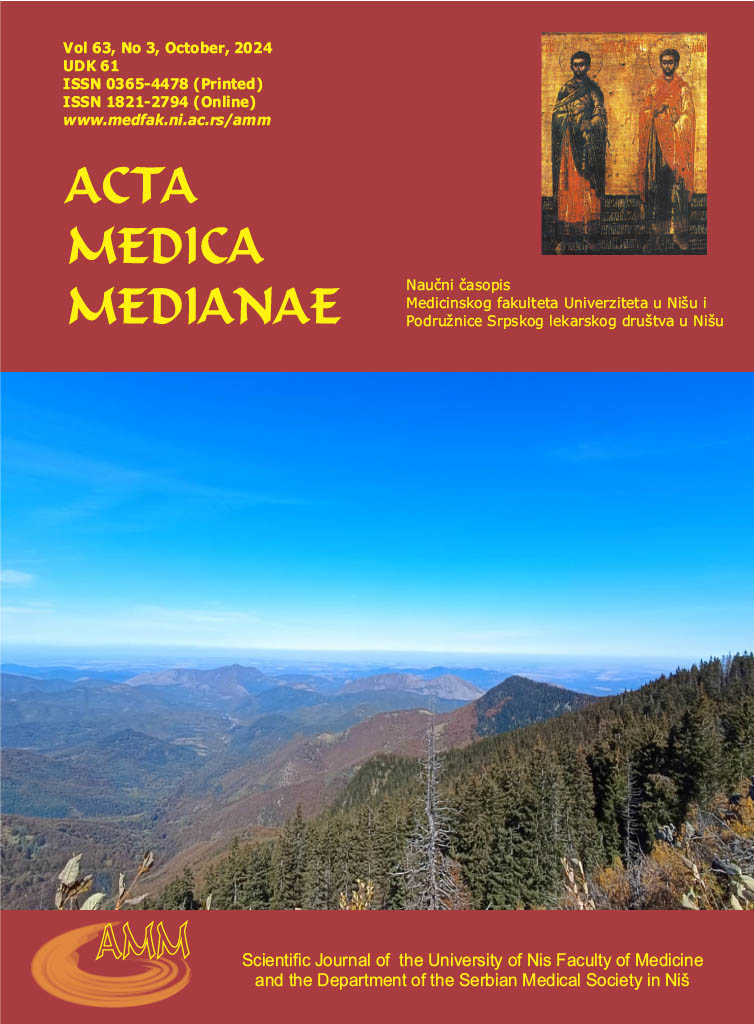HISTOLOGICAL EVALUATION OF BONE TISSUE RESPONSE TO SILICON-BASED ENDODONTIC MATERIAL
Abstract
Successful endodontic treatment implies that the materials for obturation remain in the tissue, if possible forever. It is therefore essential to know the long-term effects of materials on tissue. This study aimed to evaluate the histological response of bone tissue to the implanted dimethylpolysiloxane-based material in the artificially prepared defect. The sample comprised 20 Wistar rats. The defect was formed in the mandible of rats by sterile stainless steel burs. Dimethylpolysiloxane-based sealer (Roeko Seal) was implanted in the defects of the experimental group while the defects of the control group were left to heal spontaneously. Half of the animals from both groups were put down after thirty days, whereas the other half was euthanized after ninety days. Microscopic preparations were analyzed by light microscope. A fibrous callus and a young bone were observed thirty days after the implantation. Ninety days after the implantation, the bone around the unabsorbed material was completely healed. Roeko Seal does not decelerate the healing of bone tissue, it enables complete healing of tissue around the material.
References
Ashraf H, Shafagh P, Mashhadi Abbas F, Heidari S, Shahoon H, Zandian A, et al. Biocompatibility of an experimental endodontic sealer (Resil) in comparison with AH26 and AH-Plus in rats: An animal study. J Dent Res Dent Clin Dent Prospects 2022;16(2):112-17. [CrossRef] [PubMed]
Da Silva LAB, Bertasso AS, Pucinelli CM, da Silva RAB, de Oliveira KMH, Sousa-Neto MD, et al. Novel endodontic sealers induced satisfactory tissue response in mice. Biomed Pharmacother 2018; 106:1506-12. [CrossRef] [PubMed]
Dammaschke T, Schneider U, Stratmann U, Yoo JM, Schäfer E. Reaktionen des entzündeten periapikalen Gewebes auf drei unterschiedliche Wurzelkanalsealer. J Oral Rehabil. 2013; 17:264–8.
Derakhshan S, Adl A, Parirokh M, Mashadiabbas F. Comparing subcutaneous tissue responses to freshly mixed and set root canal sealers. Int Endod J 2009; 4(4):152–7. [PubMed]
Fonseca DA, Paula AB, Marto CM, Coelho A, Paulo S, Martinho JP, et al. Biocompatibility of Root Canal Sealers: A Systematic Review of In Vitro and In Vivo Studies. Materials (Basel) 2019; 12(24):4113. [CrossRef] [PubMed]
Garcia P, Histing T, Holstein JH, Klein M, Laschke MW, Matthys R, et al. Rodent animal models of delayed bone healing and non-union formation: a comprehensive review. Eur Cell Mater 2013; 26: 1-12; discussion 12-4. [CrossRef] [PubMed]
Gençoglu N, Türkmen C, Ahiskali R. A new silicon-based root canal sealer (Roekoseal®-Automix). J Oral Rehabil 2003;30(7):753–7. [CrossRef] [PubMed]
Ghanaati S, Willershausen I, Barbeck M, Unger RE, Joergens M, Sader R A, et al. Tissue reaction to sealing materials: different view at biocompatibility. Eur J Med Res 2010;15(11):483–92. [CrossRef] [PubMed]
Hauman CHJ, Love RM. Biocompatibility of dental materials used in contemporary endodontic therapy: A review. Part 2. Root-canal-filling materials. Int Endod J 2003; 36(3):147–60. [CrossRef] [PubMed]
Leonardo MR, Silveira FF, Silva LAB Da, Tanomaru Filho M, Utrilla LS. Calcium hydroxide root canal dressing. Histopathological evaluation of periapical repair at different time periods. Braz Dent J 2002;13(1):17–22. [PubMed]
Lodiene G, Morisbak E, Bruzell E, Ørstavik D. Toxicity evaluation of root canal sealers in vitro. Int Endod J 2008; 41(1): 72–7. [CrossRef] [PubMed]
Miletić I, Devcić N, Anić I, Borc¡ić J, Karlović Z, Osmak M. The cytotoxicity of RoekoSeal and AH Plus compared during different setting periods. J Endod 2005;31(4):307–9. [CrossRef] [PubMed]
Ogasawara T, Yoshimine Y, Yamamoto M, Akamine A. Biocompatibility of an experimental glass-ionomer cement sealer in rat mandibular bone. Oral Surg Oral Med Oral Pathol Oral Radiol Endod 2003; 96(4):458–65. [CrossRef] [PubMed]
Olsson B, Sliwkowski A, Langeland K. Subcutaneous implantation for the biological evaluation of endodontic materials. J Endod 1981; 7(8):355–69. [CrossRef] [PubMed]
Oztan MD, Yilmaz S, Kalayci A, Zaimoğlu L.A comparison of the in vitro cytotoxicity of two root canal sealers. J Oral Rehabil 2003;30(4):426-9. [CrossRef] [PubMed]
Santos GSBD, Carvalho CN, Tavares RRDJ, Silva PGDB, Candeiro GTDM, Maia Filho EM. Tissue repair capacity of bioceramic endodontic sealers in rat subcutaneous tissue. Braz Dent J 2023; 34(3): 25-32. [CrossRef] [PubMed]
Santos J, Pereira S, Sequeira D, Messias A, Martins J, Cunha H, et al. Biocompatibility of a bioceramic silicone-based sealer in subcutaneous tissue. J Oral Sci 2018; 61(1): 171-7. [CrossRef] [PubMed]
Silva EJ, Santos CC, Zaia AA. Long-term cytotoxic effects of contemporary root canal sealers. J Appl Oral Sci 2013; 21(1):43-7. [CrossRef] [PubMed]
Silva-Herzog D, Ramírez T, Mora J, Pozos AJ, Silva LAB, Silva RAB, et al. Preliminary study of the inflammatory response to subcutaneous implantation of three root canal sealers. Int Endod J 2011;44(5):440–6. [CrossRef] [PubMed]
Suzuki P, Souza V De, Holland R, Gomes-Filho JE, Murata SS, Dezan Junior E, et al. Tissue reaction to Endométhasone sealer in root canal fillings short of or beyond the apical foramen. J Appl Oral Sci 2011; 19(5):511–6. [CrossRef] [PubMed]
Tanomaru-Filho M, Tanomaru JMG, Leonardo MR, da Silva LAB. Periapical repair after root canal filling with different root canal sealers. Braz Dent J 2009;20(5):389–95. [CrossRef] [PubMed]
Trichês KM, Júnior JS, Calixto JB, Machado R, Rosa TP, Silva EJNL, et al. Connective tissue reaction of rats to a new zinc-oxide-eugenol endodontic sealer. Microsc Res Tech 2013;76(12):1292–6. [CrossRef] [PubMed]
Vujašković M, Bacetić D. Reakcija tkiva na materijale za trajno punjenje kanala korena zuba Tissue Toxicity of Root Canal Sealers. serbian Dent J. 2004;51:136–41. [CrossRef]
Washio A, Morotomi T, Yoshii S, Kitamura C. Bioactive Glass-Based Endodontic Sealer as a Promising Root Canal Filling Material without Semisolid Core Materials. Materials (Basel) 2019; 12(23):3967. [CrossRef] [PubMed]
Zafalon EJ, Versiani MA, de Souza CJ, Moura CC, Dechichi P. In vivo comparison of the biocompatibility of two root canal sealers implanted into the subcutaneous connective tissue of rats. Oral Surgery Oral Med Oral Pathol Oral Radiol Endodontology 2007; 103(5):88–94. [CrossRef] [PubMed]

